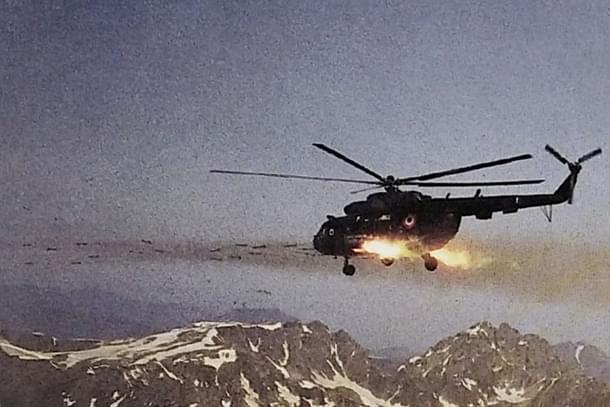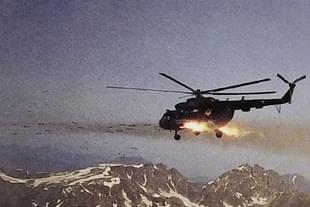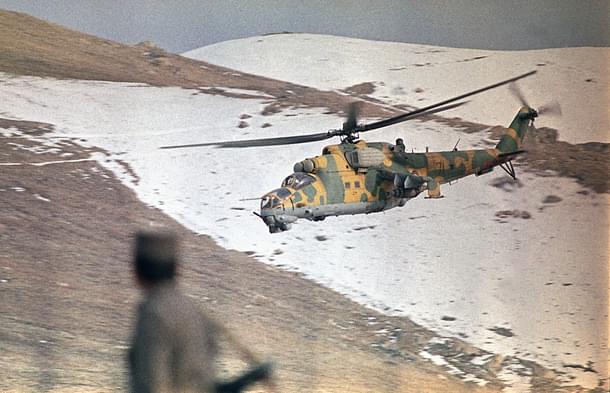Defence
Kargil: When The IAF Felt The Need For An Attack Helicopter Built For India's High-Altitude Battlefields
Prakhar Gupta
Mar 29, 2025, 09:04 AM | Updated 01:00 PM IST
Save & read from anywhere!
Bookmark stories for easy access on any device or the Swarajya app.


In early 1984, shortly after assuming the role of Director of Afghan Operations for Pakistan's Inter-Services Intelligence (ISI), Brigadier Mohammad Yousaf hosted a delegation of private American supporters of the Afghan Mujahideen.
By this time, Soviet Mil Mi-24 gunships had become a harbinger of death for the Mujahideen. Armed with a devastating 28mm machine gun turret beneath the cockpit and wings brimming with thirty-two 57mm unguided rockets, they delivered relentless fury from above. Their armoured fuselage shrugged off small arms fire as they rained destruction down on the battlefield, and the mere presence of these war machines sent Mujahideens—battle-hardened and fiercely determined, but outgunned and outmatched—scrambling for cover.
When the American delegation asked what weapon could break the Soviets’ grip on the battlefield, Yousaf didn’t hesitate—"The Stinger," he said.
A little over two years later, in September 1986, inside a small room at Ojhir Camp in Rawalpindi, a pivotal training session unfolded. A single beam of light glowed from behind a white sheet strung across the front of the room, doubling as a projector screen. Painted with a rough sketch of Afghanistan’s jagged mountains, the sheet set the stage for a lesson in survival. Afghan mujahideen from Gulbuddin Hekmatyar’s faction sat on wooden benches, watching intently.
Behind the sheet, a Pakistani soldier maneuvered a penlight, its tiny dot darting across the painted peaks like a fleeing enemy aircraft, while a Pakistani officer stood before the mujahideen, walking them through the steps to fire a Stinger missile— a man-portable, surface-to-air missile system capable of blasting Soviet gunships out of the sky.

The room was no match for the massive, multimillion-dollar Stinger training facility at Ft. Bliss, Texas, but it did the job for about a hundred bucks.
Just months earlier, a handful of Pakistani officers had been sent to the U.S. to master the Stinger after President Zia-ul-Haq agreed to let the US supply the missiles to the mujahideen—a decision he had avoided earlier, fearing Soviet reprisal. Now back from their training, the Pakistanis were tasked with teaching the mujahideen.
The US had committed to providing 250 grip stocks annually, along with 1,000 to 1,200 missiles, but once the shipments arrived in Pakistan, control over their fate slipped into the hands of the Pakistanis. The CIA handed off distribution entirely to Pakistan's ISI, trusting it to get the weapons where they were needed.
As the last Soviet military column occupying Afghanistan crossed the Amu Darya in 1989, a large number of Stinger missiles remained unaccounted for.
Kargil
A decade later, in May 1999, as the full-scale Pakistani intrusion into the Kargil, Drass, and Batalik sectors began to emerge, the Indian Army realised that it would need helicopter fire support to drive out the intruders.
On 8 May, the then Air Officer Commanding (AOC) Jammu and Kashmir, Air Vice Marshal Narayan Menon (later Air Marshal), who exercised operational control over Indian Air Force (IAF) units north of Pathankot, was asked by the Northern Command Headquarters to provide Mi-25 and Mi-35 helicopter gunships to dislodge the intruders from the heights.
"This request was made with increased urgency again on 10 May... On 11 May, the Army asked for armed Mi-17 helicopters to attack the occupied points. I transmitted the Army's request upwards as it was outside my jurisdiction to say 'Yes' or 'No'," he writes in his account of the war.
But despite these requests from the Army, the IAF remained reluctant to deploy helicopters for fire support, and the differences between the two services persisted over the next two weeks.
The Army requested fire support for attacks against enemy positions, like sangars (rock and boulder encampments), at elevations of 14,000 to 18,000 feet, above the effective operating envelope of the helicopters.
While it would be easier to spot small enemy positions from helicopters, the slow-moving aircraft would make easy targets for Pakistanis armed with shoulder-fired surface-to-air missiles.
Moreover, due to the weight and altitude-related restrictions, the Mi-25 and Mi-35 attack helicopters had never crossed the ZojiLa Pass before.
It was only in 2000, over a year after the end of the Kargil War, that a Mi-35 attack helicopter, stripped down to reduce weight, was flown across the pass successfully by the IAF, and it was done during winter, when relatively favorable temperature and air density conditions existed.
But the exercise had to be called off just after the first few sorties.
The Impasse
On learning about the Army's request for armed helicopters, the then Chief of Air Staff, Air Chief Marshal A Y Tipnis, concluded that helicopters would be vulnerable to enemy fire as they attempted to launch strikes against Pakistani positions on the heights.
He insisted that the IAF needed political clearance if it was to provide fire support to the Army.
On 14 May, in a meeting with the then Vice Chief of Army Staff Lieutenant General Chandra Shekhar, who was holding fort as the Army Chief was in Poland, Tipnis reiterated the need for the government's approval.
"I was anxious to put him at ease... To be honest, I did not think I had succeeded in generating any confidence in him," Tipnis recalls, adding, "I explained that with the conditions obtaining in the problem area, helicopters would be sitting ducks. The VCOAS left soon after, without my having a clear indication of whether he intended to approach the government."
The IAF "reserved the prerogative to give the fire support in the manner it considered most suitable," Tipnis writes.
But by 15 May, as Tipnis recalled, the Mi-17 helicopters based at Srinagar had been ordered to practice air-to-ground firing with guns and rockets at high altitudes even as the impasse continued.
The IAF had already started conducting reconnaissance sorties over the Kargil heights by 10 May, and a helicopter was targeted by a Pakistani position on 12 May but managed to land with a damaged rotor.
However, "the use of helicopters in an offensive role was denied as they would be vulnerable to the extreme," Tipnis writes.
Despite the insistent demand from the Army for armed helicopters, Tipnis continued to argue against their use as late as 23 May, when he, along with the then Navy Chief, Admiral Sushil Kumar, met Army Chief General Ved Prakash Malik, who by that time had returned to New Delhi from Poland.
As Tipnis wrote later, Malik "appeared to get agitated" at his reluctance to use armed helicopters to provide fire support.
"I told him that there was no doubt of that and the Air Force was very keen to join in. My only reservation was in respect of the use of helicopters; they would be too vulnerable," Tipnis recalls.
On 24 May, ahead of the Cabinet Committee of Security (CCS) meeting, the three chiefs met again at the Navy Chief's office.
"I picked up the discussion about the use of helicopters with Ved Malik once again," Tipnis wrote in 2006.
He added, "I explained to him that in the Ladakh region, because of the pollution-free atmosphere, the visibility is enormously better than what it is west of Zoji La.
"As the helicopters would have to approach enemy locations on the LoC ridge-line from the Kargil Valley, they would not be able to mask their approach and would be visibly picked up by the enemy well before they came into firing range.
"The effective range of the [man-portable surface-to-air] Stinger missiles [that the Pakistanis had] is much greater than that of the rockets being fired by the helicopter," he told the Army Chief.
A heated exchange on the use of helicopters followed, and General Malik, having declared his decision to "go it alone" against the Pakistanis in Kargil, "stormed out of the Navy Chief's office," the then Air Chief recalls.
It was at this point that Tipnis decided to relent.
He caught up with Malik in the corridor and told him that the Army would receive armed helicopter support from the IAF.
"Wanting to save Army-Air Force relations, I had given in against my better judgment!" he writes in his account of air operations during the war.
After discussions at the CCS meeting later that day and the day after (25 May), the Air Force received orders to launch Operation Safed Sagar.
Helicopters In Action
Equipped with 4×57mm rocket pods, carrying a total of 128 rockets, Mi-17s were pressed into operation early on 26 May.
"The fighter aircraft attacked a particular target and were immediately followed by the Mi-17 helicopter gunships," Air Marshal Menon recalls.
The gunships, one after the other, fired all 128 rockets at their targets in salvo mode before the enemy could recover from the previous attack.
To prepare the Mi-17 helicopters for these operations, the IAF had to equip them with a Counter-Measures Dispensing System (CMDS), which releases flares to deflect infrared homing (heat-seeking) surface-to-air missiles fired towards them from Pakistani positions.
This would provide the gunships much-needed protection, but there was a problem—the IAF did not have enough of these to equip all the Mi-17s being used in these operations.
"The IAF had only about four or five CMDS kits available to be strapped on to the helicopters, and an equal number of armor plates to protect the cockpits. It was decided that the first helicopter would have both the CMDS kit and armor plates, while others would have to do with some deficiency," Air Vice Marshal Manmohan Bahadur, the Staff Officer to Air Chief Marshal Tipnis during the Kargil conflict, recalls.
Tipnis' Fear Comes True
On 28 May, a six helicopter formation named Nubra was ordered to strike a feature called Point 5140 (recently renamed 'Gun Hill'). It was a dominating feature along the Tololing Ridge and one of the highest occupied positions by the Pakistani Army intruders.
However, when two of the Mi-17s part of the formation were found unserviceable just before the mission was to start, it was reduced to a four-helicopter formation.
"Nubra formation took off in time and all went on perfectly well, like clockwork," Air Commodore A K Sinha (then Wing Commander), who led the critical mission, recalls in one of his writings.
As Nubra-1, the Mi-17 with Wing Commander Sinha in it, struck its target at Point 5140 at 17,000 feet with two salvos of 64 rockets each, Pakistani intruders at the heights started firing Stinger missiles at the helicopter.
Two Stingers, fired from different locations, "skimmed past the wind screen of Nubra-1," Air Commodore Sinha recalls.
Stinger missiles were fired at each of these Mi-17s, but they were deflected by CMDS flares, except in the case of Nubra-3, Squadron leader Rajiv Pundir's aircraft. It was not equipped with a CMDS.
As Nubra-3 was turning away after a successful strike, a Stinger missile fired from a Pakistani position in the vicinity hit its engine and brought down the helicopter with its aircrew of four.
"It had also been thought by many including me that there would be a reduction in the performance of these missiles when fired from the heights of 3 km and above. This turned out to be wrong as the performance envelope of the missile expands because of the increased temperature differential between the missile seeker head and the jet exhaust of aircraft," Air Marshal Menon writes in his account.
The loss of Nubra-3 on 28 May forced the IAF to pause and rethink, and Mi-17 helicopters were temporarily taken off from all strike missions.
Nearly 25 years later, the government has signed a deal to buy 156 Prachand Light Combat Helicopters—purpose-built in India for Indian battlefields—marking not just the procurement of an indigenous weapons platform, but a long-overdue reckoning with the lessons of war, paid for in blood.
Prakhar Gupta is a senior editor at Swarajya. He tweets @prakharkgupta.





